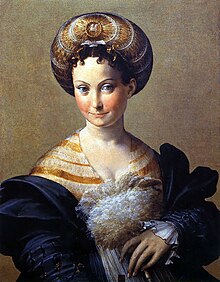|
Balzo headdress The Balzo was a headdress worn by noblewomen of Italy in the 1530s. It was donut-shaped but appeared turban-like from the front, though it was generally worn further back from the forehead exposing the hair, unlike a period turban. It is assumed as a fashion invention by Isabella d'Este, first documented in letters in 1509 and 1512[2] and well copied in later years. The headdress was a throwback to a larger rounded headdress from the 15th century in Italy that covered the hair of the wearer.[3] Then the hairline was often plucked. Though mostly known as a woman's headdress, there is evidence that men also wore a form of the balzo.
References
Wikimedia Commons has media related to Balzo. |


